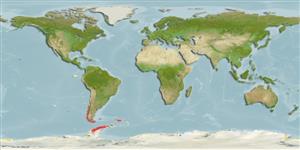Common names from other countries
Classification / Names / Names
Namen | Synonyme | Catalog of Fishes (gen., sp.) | ITIS | CoL | WoRMS
Environment: milieu / climate zone / depth range / distribution range
Ökologie
; tiefenbereich 10 - 610 m (Ref. 87801). Polar; 46°S - 74°S, 77°W - 35°W
Southeast Pacific and Antarctic Atlantic.
Length at first maturity / Size / Gewicht / Alter
Maturity: Lm ? range ? - ? cm
This is a benthic mobile species found on primnoid gorgonians at depths of 10 to 610 m. It has a mouth capable of opening very wide, allowing it to prey on octocorals (Ref. 87801). Solitary (Ref. 2377).
Life cycle and mating behavior
Geschlechtsreife | Fortpflanzung | Ablaichen | Eier | Fecundity | Larven
Members of the class Anthozoa are either gonochoric or hermaphroditic. Mature gametes are shed into the coelenteron and spawned through the mouth. Life cycle: The zygote develops into a planktonic planula larva. Metamorphosis begins with early morphogenesis of tentacles, septa and pharynx before larval settlement on the aboral end.
Southern Ocean Mollusc Database (SOMBASE). 2011. (Ref. 87340)
IUCN Rote Liste Status (Ref. 130435)
CITES Status (Ref. 108899)
Not Evaluated
Not Evaluated
Nutzung durch Menschen
| FishSource |
Tools
Mehr Information
Alter/Größe
Wachstum
Länge-Gewicht
Länge-Länge
Morphologie
Larven
Dichte
Internet Quellen
Estimates based on models
Preferred temperature
(Ref.
115969): 0.5 - 9.8, mean 7.1 (based on 46 cells).
Preiskategorie
Unknown.
